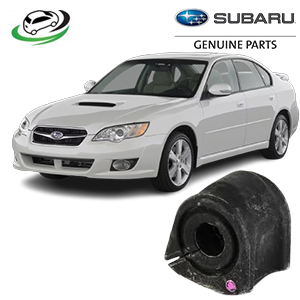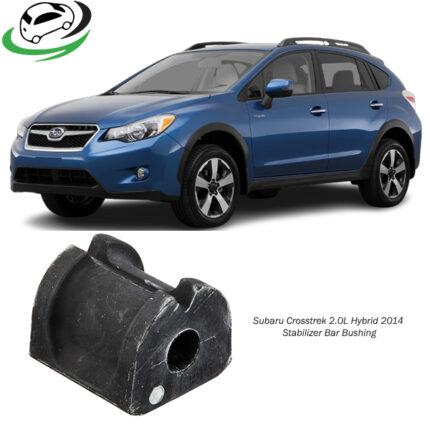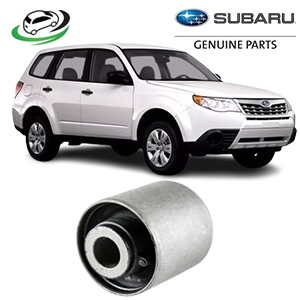Get Subaru Forester 2.5L 4AT X 2011 Suspension Control Arm Bushing 20254FG010
The suspension control arm bushing is a vital component of a vehicle’s suspension system. It plays a crucial role in providing stability, control, and comfort while driving. In this comprehensive guide, we will explore the functions, benefits, components, signs of wear, maintenance tips, and replacement procedures related to suspension control arm bushings.
1. What are Suspension Control Arm Bushings?
Suspension control arm bushings are rubber or polyurethane components that serve as a connection between the control arm and the vehicle’s frame or chassis. They are designed to absorb shocks and vibrations while allowing for the necessary movement of the control arm during driving maneuvers. Control arms are responsible for connecting the wheels to the vehicle’s frame, allowing for controlled wheel movement during suspension compression and extension.
Structure and Composition
- Bushings: Typically made of rubber or polyurethane, these bushings provide cushioning and flexibility to accommodate suspension movement while minimizing noise and vibrations.
- Control Arms: The control arms themselves are metal structures that connect the suspension components to the vehicle’s chassis.
- Mounting Points: The bushings are fitted into mounting points on the control arms and the chassis, allowing them to pivot and rotate as needed.
2. Functions of Suspension Control Arm Bushings
Suspension control arm bushings perform several essential functions within the suspension system:
a. Absorbing Shocks and Vibrations
One of the primary functions of control arm bushings is to absorb shocks and vibrations from the road. This absorption contributes to a smoother ride and minimizes the transfer of road noise into the cabin.
b. Allowing for Suspension Movement
Control arm bushings provide the necessary flexibility for the control arms to pivot and rotate. This movement is essential for accommodating changes in road conditions and suspension travel during acceleration, braking, and cornering.
c. Reducing Friction
The bushings reduce friction between the control arms and the chassis, allowing for smoother operation and preventing wear on suspension components.
d. Maintaining Alignment
Properly functioning control arm bushings help maintain the alignment of the wheels. This alignment is crucial for optimal handling, tire wear, and overall vehicle stability.
e. Providing Stability and Control
By allowing controlled movement and reducing body roll during turns, suspension control arm bushings contribute to the overall stability and control of the vehicle.
3. Benefits of a Properly Functioning Suspension Control Arm Bushing
A well-maintained suspension control arm bushing offers numerous benefits to the vehicle’s performance, handling, and comfort:
a. Improved Ride Quality
Functional control arm bushings absorb road impacts and vibrations, resulting in a smoother ride for both the driver and passengers.
b. Enhanced Handling
A properly functioning suspension system improves handling, responsiveness, and stability, especially during cornering and sudden maneuvers.
c. Reduced Tire Wear
By maintaining proper wheel alignment, control arm bushings help prevent uneven tire wear, extending the lifespan of tires.
d. Increased Suspension Longevity
By minimizing friction and wear, well-maintained control arm bushings contribute to the longevity of other suspension components, reducing the need for costly repairs.
e. Enhanced Safety
A stable suspension system ensures better control of the vehicle, improving safety during driving, especially in adverse conditions.
4. Signs of a Failing Suspension Control Arm Bushing
Recognizing the signs of a failing suspension control arm bushing is crucial for maintaining vehicle performance and safety. Common indicators include:
a. Clunking or Knocking Noises
A failing control arm bushing may produce clunking or knocking sounds, particularly when going over bumps or during turns. These noises can indicate that the bushings have worn out and are no longer providing proper cushioning.
b. Poor Handling and Stability
If you notice a decline in handling or increased body roll while cornering, it may be a sign that the control arm bushings are compromised.
c. Uneven Tire Wear
Worn control arm bushings can cause misalignment of the wheels, resulting in uneven tire wear. If you notice unusual wear patterns on your tires, it’s essential to inspect the bushings.
d. Vibration in the Steering Wheel
Excessive vibrations in the steering wheel while driving may indicate that the control arm bushings are worn or damaged, affecting the overall stability of the vehicle.
e. Visual Inspection
A visual inspection of the control arm bushings may reveal signs of cracking, deformation, or separation from the control arm or chassis, indicating that they need replacement.
5. Maintenance of Suspension Control Arm Bushings
Regular maintenance of suspension control arm bushings is vital for optimal performance and longevity. Key maintenance practices include:
a. Routine Inspections
Conduct routine inspections of the control arm bushings during regular vehicle maintenance. Look for visible signs of wear, such as cracks or deterioration, and check for any loose connections.
b. Monitor Handling and Steering
Pay attention to how your vehicle handles while driving. If you notice changes in steering response, increased body roll, or unusual noises, inspect the control arm bushings for potential issues.
c. Lubrication
Some control arm bushings may require periodic lubrication to reduce friction and wear. Follow the manufacturer’s recommendations regarding lubrication and maintenance intervals.
d. Addressing Noises Promptly
If you hear clunking or knocking noises, address them promptly. Ignoring these sounds can lead to further damage and more expensive repairs.
e. Replacement of Worn Components
If the control arm bushings show signs of wear or damage, it is essential to replace them as soon as possible to prevent further issues with the suspension system.
6. Steps to Replace Suspension Control Arm Bushings
Replacing suspension control arm bushings is a process that can typically be performed with basic tools. Here’s a general outline of the steps involved:
1. Gather Necessary Tools
You will need basic hand tools, including a socket set, wrench, torque wrench, and possibly a bushing removal tool. Have the replacement bushings on hand.
2. Raise the Vehicle
Using a jack, raise the front or rear of the vehicle (depending on which control arm bushing you are replacing) and secure it on jack stands. This will provide better access to the control arm and bushings.
3. Remove the Wheel
If you are replacing a front control arm bushing, remove the wheel to gain access to the control arm assembly.
4. Disconnect the Control Arm
Using the appropriate socket or wrench, disconnect the control arm from the chassis. Take note of the orientation and position of the control arm for reinstallation.
5. Remove the Old Bushings
Locate the old control arm bushings and use a bushing removal tool to extract them from the control arm. Carefully remove the old bushings and inspect the control arm for any signs of damage.
6. Clean the Control Arm
Before installing the new bushings, clean the control arm and the area where the bushings will be mounted. This ensures a proper fit and helps prevent premature wear.
7. Install the New Bushings
Place the new bushings into the control arm in the same orientation as the old ones. Ensure that they are seated correctly and securely.
8. Reattach the Control Arm
Reconnect the control arm to the chassis, ensuring that all bolts are tightened to the manufacturer’s torque specifications. Properly securing the control arm is crucial for maintaining suspension integrity.
9. Reinstall the Wheel
If you removed the wheel, reinstall it and ensure that all lug nuts are tightened to the specified torque.
10. Lower the Vehicle
Once everything is reassembled, carefully lower the vehicle back to the ground. Ensure that all components are secure and that there are no tools left under the vehicle.
11. Test Drive the Vehicle
After replacing the control arm bushings, take the vehicle for a test drive. Monitor for any signs of improved handling, reduced noise, or any lingering issues.
Conclusion
Suspension control arm bushings are essential components of a vehicle’s suspension system, providing stability, comfort, and control. Understanding their functions, benefits, maintenance practices, and signs of wear can help vehicle owners take proactive steps to ensure their vehicles remain in optimal condition. Regular inspections, timely replacements, and proper maintenance of suspension control arm bushings contribute to improved vehicle performance, increased longevity, and a safer driving experience. By keeping these critical components in good condition, drivers can enjoy the peace of mind that comes with a well-functioning suspension system.
Follow us on Facebook for more parts.




Reviews
Clear filtersThere are no reviews yet.